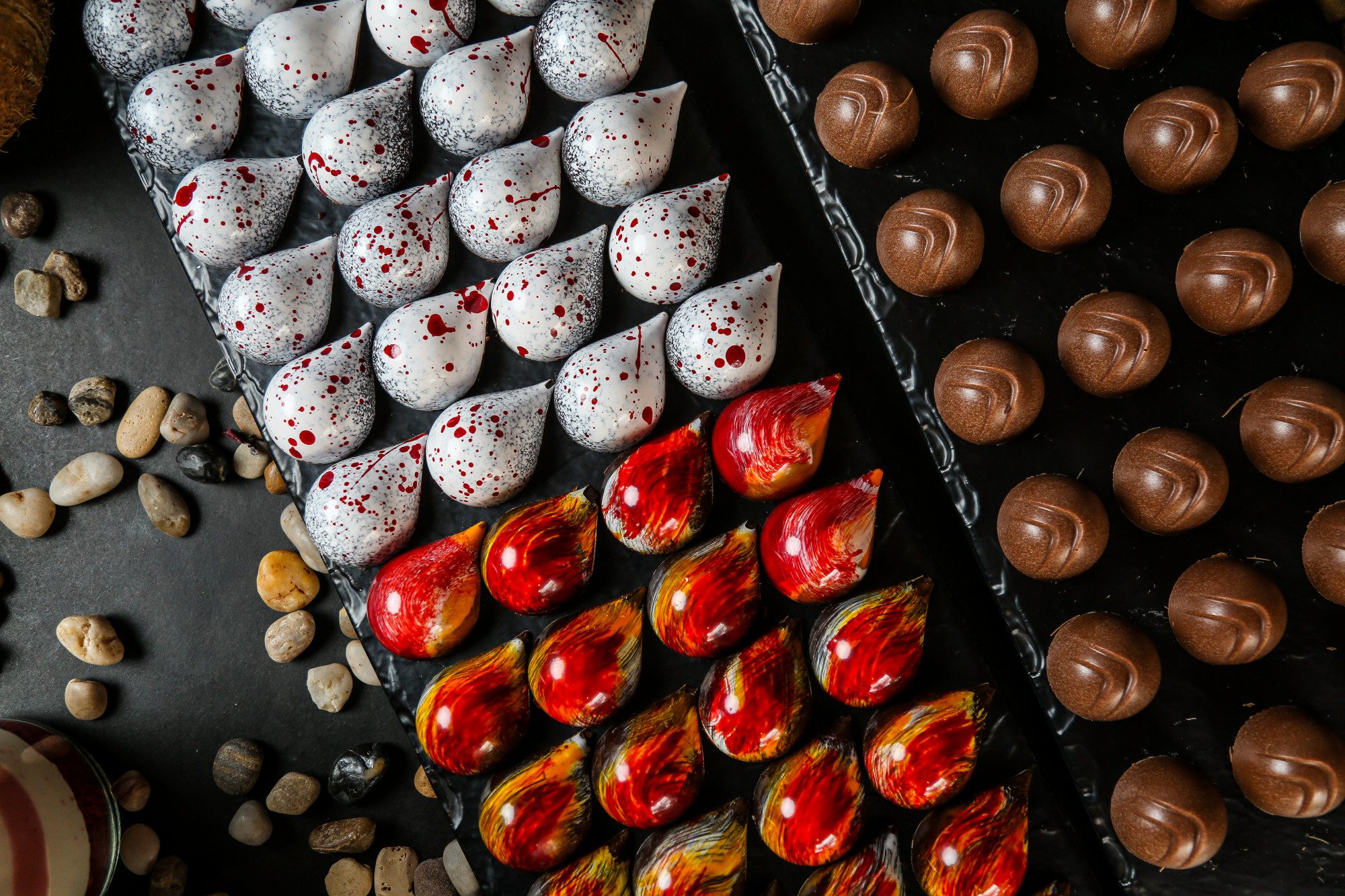The importance of good lighting in a chocolate store
Every chocolate store is all about experience. The delicious smells, the sophisticated decor and, above all, the beautiful presentation of chocolate products. An often underrated factor that brings all these elements together is good lighting. In this article, we dive deep into why the right lighting is so important for chocolatiers and store owners. We cover how lighting affects product presentation, atmosphere, customer experience and even sales. We also discuss technical aspects such as color temperature store lighting chocolate, color rendering(CRI) and light dispersion. Finally, you will get tips for window lighting and learn more about the customized lighting plan for chocolate stores. Read on and find out how to make a chocolate store even more beautiful with thoughtful store lighting.
Why lighting can make or break a chocolate store
In retail, “People eat with their eyes.” No matter how delicious the chocolates or truffles are, if they don’t look attractive, customers will be less inclined to buy them. Lighting plays a key role in this, sometimes even more than the layout of the store itself
viewer.
Specialists stress that lighting can make or crack a store, In a chocolate store it is no different. The right light puts a spotlight on the chocolates, bars and chocolates and literally makes them shine.
Good lighting is important for the coziness and atmosphere in the business. And that atmosphere largely determines the customer experience. Warm, inviting light can make customers feel at ease and keep looking around longer. Too bright or unsociable light can have the opposite effect. Lighting should be used to set the right accents. Show the customer what you want to sell. In a chocolate store, this often means, highlight your finest chocolate creations without letting the light overwhelm or distract.
In addition, research has shown that improved store lighting can have a direct positive impact on buying behavior. As an example, a Dutch retail chain reported a 15% increase in sales after they renewed and optimized their store lighting. Customers stayed longer in the store and appreciated the new lighting atmosphere, which translated into more purchases. A well-thought-out lighting plan can keep customers in the store longer, so to speak, and stimulate their appetite for buying. In short, in our opinion, investing in the right lighting is not an unnecessary luxury, but a must for every retailer. Especially in an industry where enticing customers to taste is key.
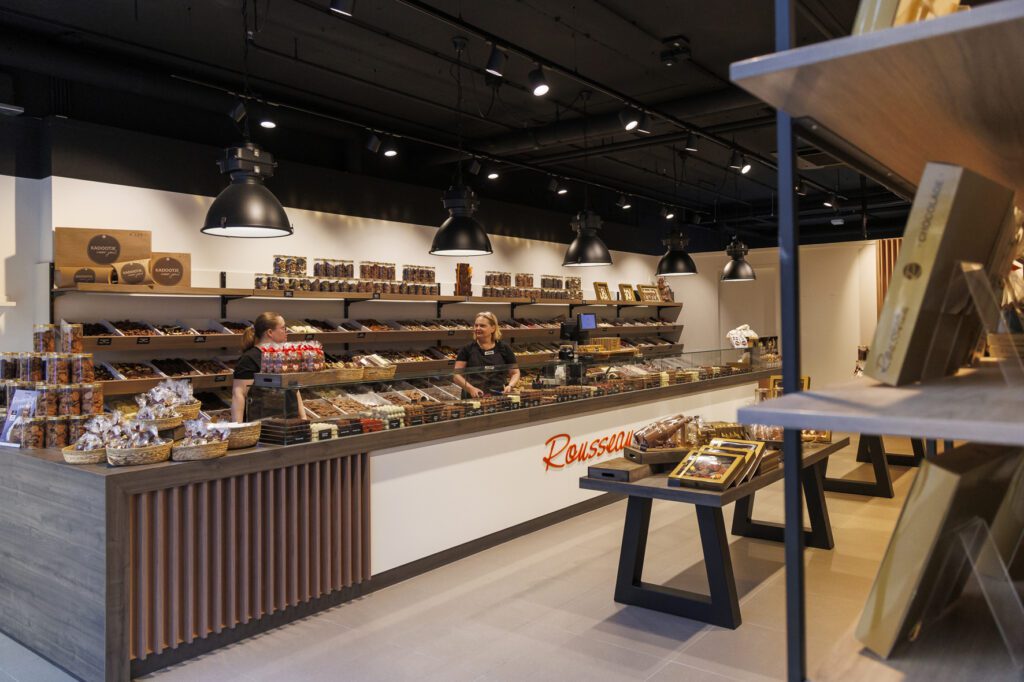
Makes chocolate look irresistible
Chocolate products are delicate and their appearance is greatly affected by the light under which they are presented. With the right lighting, you can make the most of chocolate’s colors, textures and shine. For example, milk chocolate gets that deep, creamy sheen and white chocolate stays beautifully creamy. However, experts call chocolate “a very difficult product in terms of lighting.” Why? Chocolate, especially the brown tones, benefits from warm light with enough reds in the spectrum. Standard LED lighting often has a cooler, blue-white glow. LEDs naturally have a blue diode, which can make brown chocolates look bland or less flavorful. White chocolate even loses its warm, creamy appearance under too blue light and looks rather white-gray.
Color temperature is also essential here. In fresh food stores, warm-white color temperatures are typically used to make food more appealing. For chocolate stores, we usually recommend a color temperature around 2700K and 3000K, similar to warm halogen or incandescent light. Such a warm color temperature accentuates natural brown tones and gives the products an inviting glow. In a recent project, a chocolatier deliberately chose 2700K lighting to present chocolate in an extra tasty way. That warm hue allows customers to almost taste the chocolate with their eyes.
In addition, color rendering (CRI) is very important. The CRI value indicates how faithfully colors are rendered under a light source. Chocolate has subtle color differences, think of the reddish-brown sheen of dark cocoa or the slight yellow tint of white chocolate. To see all these nuances, a high CRI is needed. Therefore, a CRI of at least 90 is recommended for chocolate lighting. With such a high color rendering index, the colors come out perfectly and customers see the chocolate as it really is. Fresh, artisanal and mouth-watering!
Finally, light intensity also plays a role in product presentation. One would think: the more light, the better the products stand out. But for chocolate, this does not always hold true. Overexposure can actually be counterproductive. Too much bright light on chocolate can negatively affect its color and quality. The chocolates then look different than they really are. In fact, excessive lighting can cause chocolate products to discolor or dull faster. Chocolatiers are familiar with the phenomenon of “bloom” (white haze) on chocolate, which can result from temperature fluctuations or exposure to improper lighting. So the trick is to provide enough brightness so that the wares stand out, without constantly putting them in a bowl of bright light. In other words, less can be more. With strategically placed spotlights and a balanced general light, the chocolate retains its natural complexion and fresh appearance while still being prominently presented.
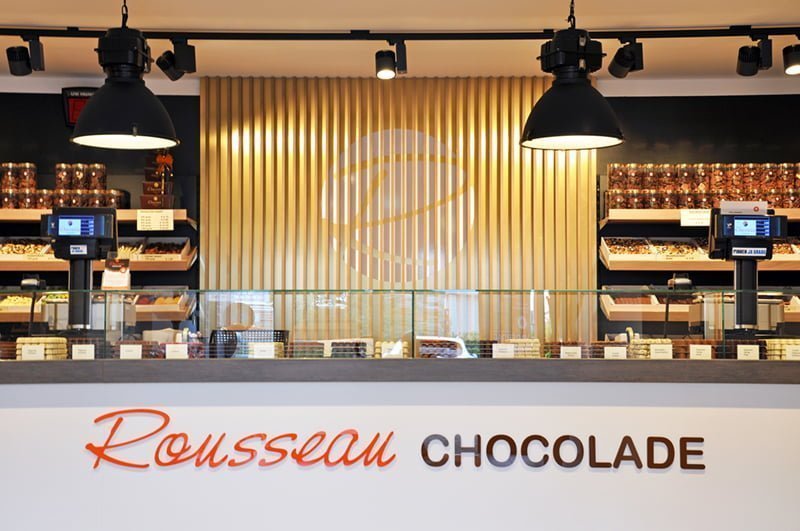
Lighting creates ambiance
In addition to presenting products, lighting is the way to set the desired atmosphere in a chocolate store. Consider what experience you want customers to have as soon as they step inside. Is it a warm, cozy artisan chocolate shop with wooden furniture and the smell of cocoa? Or a sleek, modern boutique where luxury chocolates are displayed like gems? With light, you can actively shape this atmosphere.
First of all
light influences the emotion
of the customer. Warm, dimmed light with amber or gold tones creates a sense of reassurance and luxury, befitting the artisanal and seductive nature of chocolate. Customers feel at ease and take time to browse around. Bright white or chilly light, on the other hand, can make a space feel unsettled or clinical, not conducive to enjoyment. Lighting is emotion, it is often said. So at a time when shopping experience is a high priority, light should contribute optimally to the desired emotion. Whether that is warmth, exclusivity, nostalgia or modernity.
In addition, lighting can direct customers’ routing and focus. By lighting certain areas brighter and keeping others more intimate, you guide visitors’ gaze through the store. For example: slightly brighter lighting above the presentation of luxury gift chocolates attracts attention, while a cozy corner with a tasting tray in atmospheric soft light again invites one to pause and taste. Store lighting ideally consists of a combination of general lighting and accent lighting. General basic lighting provides enough light for comfortable looking and choosing, while accent lighting determines the attractiveness of the store as well as the products. With the right spotlights above product displays, you can emphasize what really needs to be seen, the showpieces of a chocolate collection.
Of course, every store is different. There is no one-size-fits-all solution to ambience. Factors such as interior color, ceiling height and the presence of natural light all play a role. What works perfectly in one chocolate store may have a completely different effect in another. It is therefore important to devote time and attention to a good and well-founded lighting plan. More on this later in this article.
One thing is certain. A well-tuned lighting atmosphere increases customer satisfaction. Customers who feel comfortable in a store will stay longer, view more products and are more likely to buy something. Lighting thus contributes directly to both customer experience and sales. So create an atmosphere that fits the story of the business. Whether that’s nostalgic, modern, cozy or elegant. And let your customers enjoy both the chocolate and the environment.
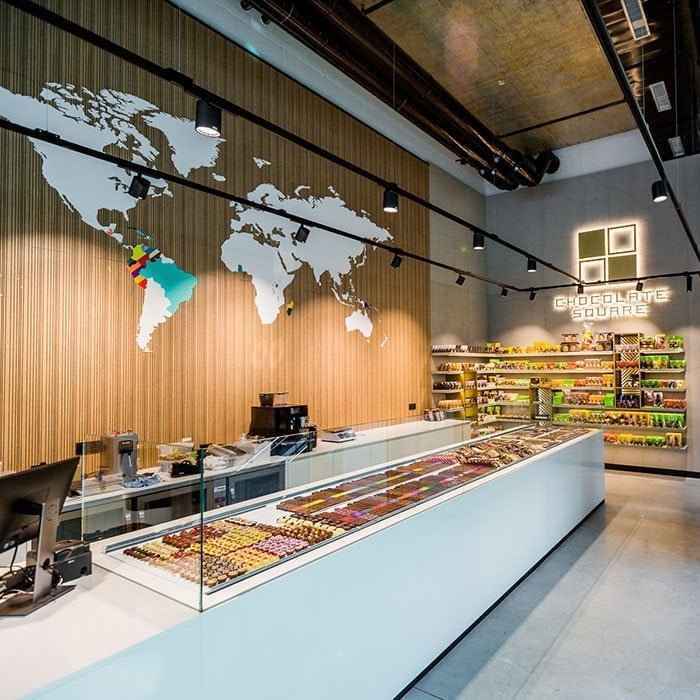
A chocolate store with a sleek and modern interior.
Lighting technology for chocolate stores
Behind every successful store lighting solution is a piece of technology. Understanding some basic technical concepts will help you make better choices or have an easier conversation with a lighting partner. We highlight four key aspects: color temperature, color fastness (CRI) light distribution and heat.
Color temperature is expressed in Kelvin (K) and determines whether light feels warm (yellower) or cool (whiter/bluer). As mentioned earlier, chocolate does well visually at warmer color temperatures. Warm-white light (~2700K, similar to candlelight or an incandescent bulb) gives a cozy glow and makes brown tones appear richer. Neutral-white (about 4000K), on the other hand, can appear too clinical and push the warm colors of chocolate into the background. A real-life example: a chocolate brand experimented with different light colors and finally chose 3000K as the ideal balance for them. This warm-white light made the chocolates visibly more appealing to the customer’s eye. So it pays to think carefully about the color temperature in your own business. One often ends up with 2700K-3000K for main lighting, possibly with slightly more neutral light (3500K) in specific areas to provide contrast, depending on the materials used in the interior
Color rendering index (CRI) we have also discussed briefly. This value (0-100) indicates how accurately a light source makes colors appear compared to daylight. A high CRI is particularly important in a chocolate store because you want to show the fine differences between dark, milk and white chocolate. As well as any colorful decorations or bonbon fillings. LED lighting today is available with CRI values of 90 and higher, meaning that colors are rendered true to life. Preferably choose fixtures with CRI ≥ 90 for product lighting. For example, the reddish-brown tones in cocoa come out fully and white chocolate still looks creamy instead of yellowish or grayish. Some specially developed LED modules for fresh produce present a modified light spectrum
Third, light distribution and direction is something to consider. How is the light distributed in the room and on the products? In a chocolate store, you want even basic lighting without harsh shadows in display cases or across the counter. Spot or track lighting should be directed so that every corner of the display case is well lit, but that there is no glare for the customer looking in. Track spots or directional spotlights are ideal for this because they allow you to focus the light exactly where needed. Our lighting specialists are happy to align the lighting for you, so you can be sure that all the lighting is in the right position at the time of (re)opening. We often combine multiple beam widths: narrow beams to accent specific product groups (e.g. a spotlight on an exclusive bonbon collection), and wider beams or general downlights to fill the room with light. Be sure to light vertical surfaces (such as the back wall with shelves full of chocolate letters or bars) as well. Vertical lighting gives the space depth and ensures that products at eye level are directly in view. A rule of thumb: general lighting for overview, accent lighting for focal points. Together, they create a dynamic but balanced light image that is both functional and attractive.
Finally, the aspect of heat and UV radiation should not go unmentioned. Chocolate is sensitive to heat. Too much heat makes it melt or causes fat bloom, and UV light can negatively affect shelf life and color. Traditional halogen lights, for example, can get quite hot and also emit UV, which is undesirable in a chocolate store. LED lighting has a clear advantage here: quality LED lamps emit much less heat or UV radiation in the light beam. As a result, the products stay cooler and are not exposed to UV light that can affect quality. Moreover, this also saves on cooling. The display case and store don’t have to cool as much to keep the chocolate fresh. From a sustainability point of view, LED is the standard anyway: energy-efficient, long life and nowadays available in all shades and CRI values you could want.
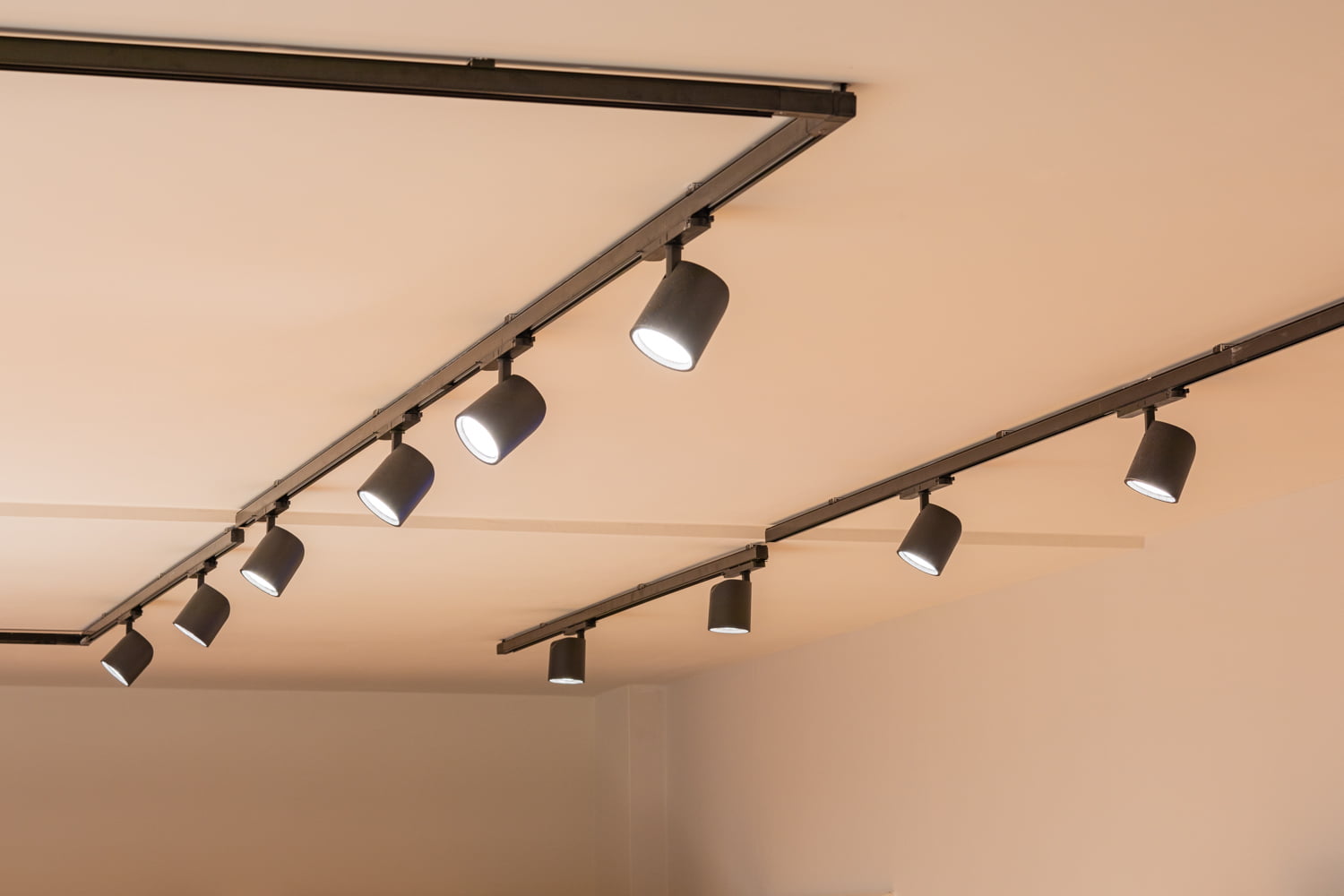
Track spots that can be specifically targeted to areas or products.
Shop window lighting, the eye-catcher of the store
In all the thinking about interior lighting, don’t forget about window lighting. The window is the chocolate store’s business card and often the first impression a potential customer makes. Window lighting for a chocolate store plays an important role in this regard. It can make the difference between passersby walking through and passersby standing still salivating.
A number of guidelines apply to optimal window presentation of chocolate. First, ensure adequate light contrast with the surroundings. During the day, this means that window lighting should be powerful enough to stand out next to daylight and sunlight. But avoid direct sunlight on the chocolate, which can cause melting and discoloration. At night and in the dark months, you want the window display to cast a warm glow on the sidewalk. For example, use spotlights that focus well on the window products. Place them so that they highlight the most beautiful pieces of chocolate. A pyramid of chocolates, a show piece of a chocolate sculpture, or luxury gift packaging. Directional spotlights or track spots come in handy to get the light exactly where you want it. Make sure there is sparkle on the products: a subtle shine on a praline or a reflection on foil makes the image vibrant and attracts attention.
A second aspect is layering in window lighting. Combine background light, main light and accents. For example, place a soft background light (such as a warm LED strip) along the edges or back wall of the window display to create depth. Add some fixtures that illuminate the general scene. And finally, use a few narrow spotlights to accent individual products or décor pieces. These layers make the window display look not flat, but dimensional and interesting. Also, you avoid harsh shadows this way. A fill-in light from the front combined with accent light from the side or top gives a nicely balanced effect, so that all details are visible.
Also consider the store entrance as part of the window display experience. An illuminated entrance area acts as a magnet. In some successful chocolate stores, the entrance is lit a little stronger than the back part of the store, so it stands out from the outside and entices customers to step inside. That light boost at the door or window attracts attention at street level. Once inside, the lighting can then gradually change to the atmospheric tone you desire inside.
Finally, it’s smart to leave your storefront lighting on longer in the evening, even after closing time. A beautifully lit window display also attracts the attention of passersby outside of opening hours. It keeps your store in the minds of potential customers, who may come back later to buy that one attractive box of chocolates they saw gleaming in the window in the evening. With energy-efficient LED lighting, the extra cost is minimal, while the effect on your visibility is significant.
Summary: Treat the window as a small theater in which your chocolate plays the lead role. Light is the director, use it to tell a story that draws people inside. Apply the tips above for window lighting chocolate products and you’ll find that your store attracts more viewers.
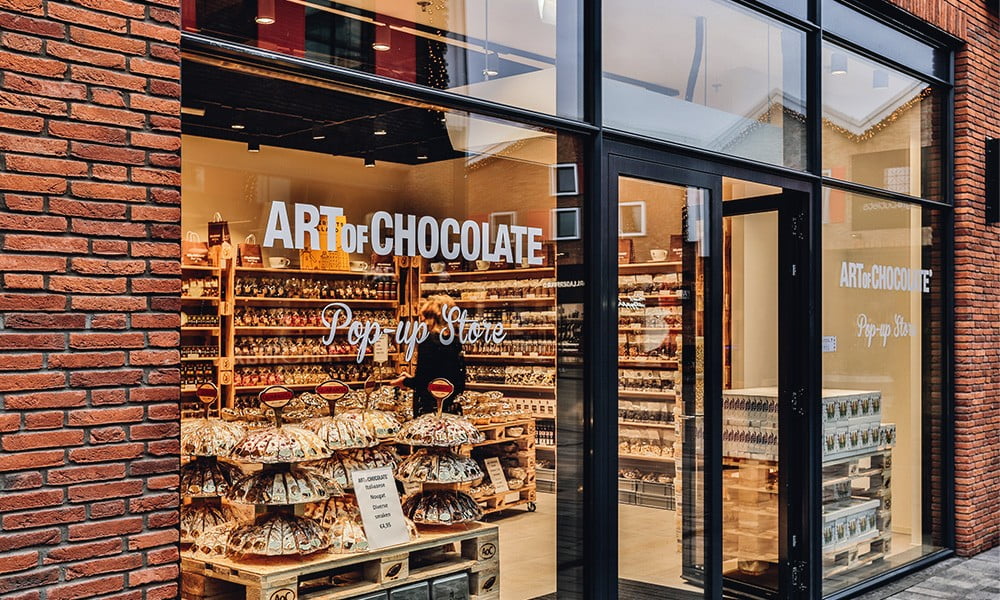
A warm, artisanal and inviting window display.
A customized lighting plan for your chocolate store
Every retail space is unique, and as mentioned earlier, there is no standard recipe that fits every chocolate shop. Therefore, creating a
custom lighting plan
so important. A lighting plan for a chocolate store takes into account all facets of the store. The layout, color scheme, product presentation, as well as practical issues such as power points and energy savings. A well thought-out plan prevents surprises later and ensures a coherent lighting concept in which all elements are correct.
Experienced lighting contractors work step by step on such a lighting plan. First we map out what the wishes and goals are. Do you mainly need to accentuate products in the display cases? Does the store need to appear more spacious? Do you want to save energy or be able to set dynamic lighting scenes? This inventory of needs forms the basis of our lighting plan. Then we look at the characteristics of the space: surface area, ceiling height, colors and materials present, amount of daylight, and so on. Based on this, we choose the right fixtures for each zone. In our lighting plans, we often divide a store into zones, with the ideal solution for each zone in terms of spectrum, intensity and atmosphere. In a chocolate store, you might think of zones such as: the display window, the counter/sales area, the shelves along the wall, any seating or tasting areas and the staff work area. Each zone requires its own approach. So creating a lighting plan means making choices for each area while still ensuring that the whole is a harmonious balance. Our lighting designers have years of experience creating lighting plans, including for chocolate stores.
A sound lighting plan also takes into account durability, style and ease of use. Three important aspects of good lighting design. Sustainability is about energy efficiency, product use and future-proofing. Circular lighting and LED lighting obviously score high here. For example, smart lighting systems can dim or switch on time/schedule to save energy. Stylish concerns ambiance and appearance. Which fixtures match the style of the store and which light colors reinforce the house style? Dthink warm light for a nostalgic look or slightly cooler modern light if you are aiming for a sleek, upscale look. Finally, ease of use looks at the practical side: is the lighting easy to operate, maintain and flexible if the store layout changes? A good lighting plan takes all of these things into account so that you are satisfied not only now, but also in the long term.
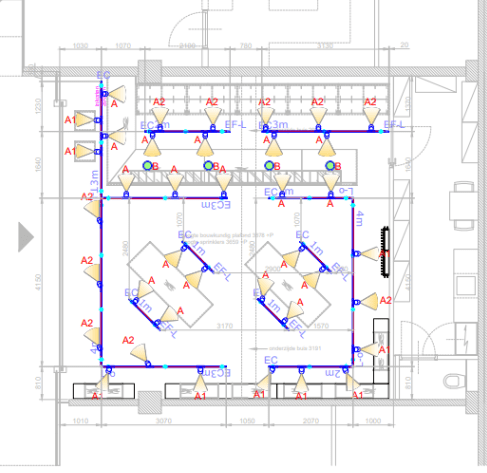
We are happy to help!
Want to improve the lighting in your chocolate store but don’t know where to start? Or are you curious how an expert lighting plan can transform your retail space?
Ask for free lighting advice
. Our experienced lighting consultant can examine the situation on site and make proposals based on the latest insights and techniques. This will immediately give you valuable ideas, from quick wins (e.g. placing other lamps in the shop window) to a completely new lighting design.
Don’t hesitate to take this step. As we have seen, the right lighting can make a world of difference for the presentation of chocolate, the atmosphere in the store and the buying behavior of your customers. Investing in light is investing in experience and sales. Let your chocolate store shine and draw customers in with an irresistible ambiance. Contact us today for customized lighting advice without obligation. And discover how you can let your chocolate products shine with the perfect lighting and let your customers leave with a smile.

